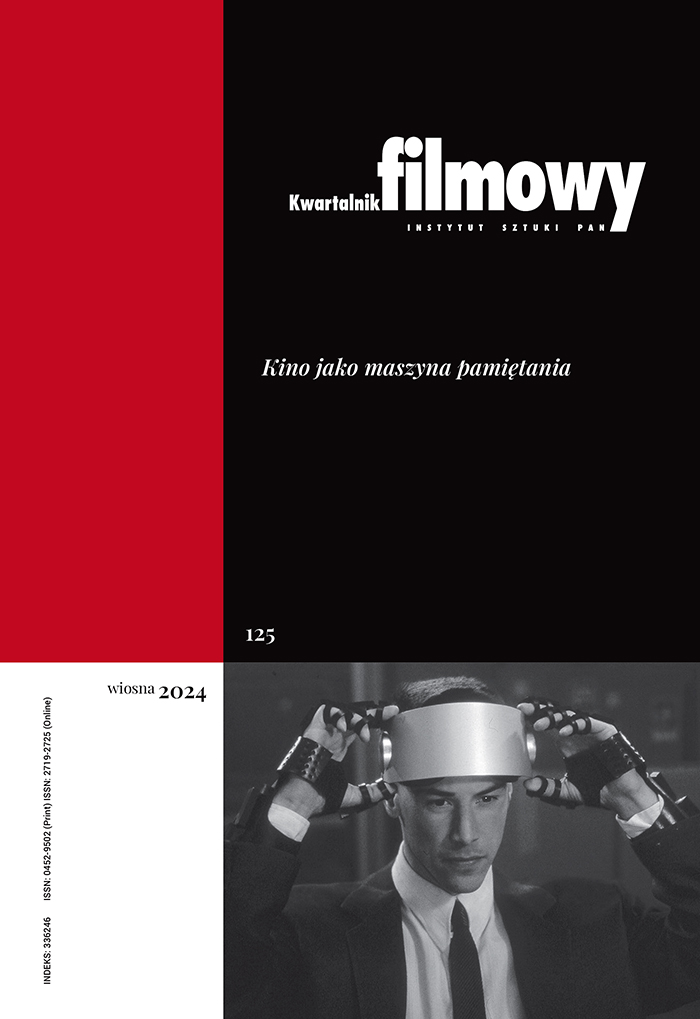That Which Doesn’t Exist: Memories and Accounts of Women Who Participated in the Warsaw Uprising as Ready Made, but Unused Film Scripts
Abstract
In Polish feature films about the Warsaw Uprising there are no women. They of course appear as nurses, civilians or message runners. But they are always part of the background, seen, but not looking, symbolic in their presence, and never the active heroines; always serving, and never independent or autonomous. If they are the heroines of the drama, then they are part of someone else’s drama, and are not given a voice of their own. Their narratives and accounts of life, even everyday life, are left unsaid, hidden behind grand and epic narratives of the heroes. The article is about women’s “micro-narratives”, the memories of women who lived in Warsaw and participated in the Warsaw Uprising in 1944. The memories give us a chance to see the Uprising in a different light, one that includes the women’s perspective and experience of the Uprising. Women’s accounts, due to their graphic nature and their uniqueness appear to be ready made film scripts, that have yet to be filmed.
Keywords:
Warsaw Uprising, women, herstories, micro-narrativesReferences
Chutnik Sylwia, Kieszonkowy atlas kobiet, Korporacja Ha!art, Kraków, 2008, s. 100-101.
Google Scholar
Foks Darek, Zbigniew Libera, Co robi łączniczka, Instytucja Kultury Ars Cameralis Silesiae Superioris, Katowice 2005.
Google Scholar
Gil Maciej, Warszawa, sierpień 1944. Temat na dziś: film o Powstaniu (dyskusja), „Kino” 1996, nr 9, s. 12-15.
Google Scholar
Janion Maria, Wojna i forma, w: taż, Płacz generała. Eseje o wojnie, Sic!, Warszawa 2007, s. 25-26, 28, 68, 82-83, 88.
Google Scholar
Komar Michał, Opisanie i wyjaśnienie części powodów, dla których w literaturze polskiej – mam tu na myśli powieść, dramat i scenariusz filmowy – nie powstało do tej pory i pewnie w najbliższych latach nie powstanie wielkie dzieło o czasach wojny i okupacji, „Dialog” 1973, nr 4, s. 150.
Google Scholar
Ostrowska Elżbieta, W Alejach spacerują „Tygrysy”. Sierpień – wrzesień 1944, PIW, Warszawa 1973, s. 62, 80, 87, 240, 268-290.
Google Scholar
Pełnić służbę... Z pamiętników i wspomnień harcerek Warszawy 1939-1945, red. A. Zawadzka, Z. Zawadzka, PIW, Warszawa 1983.
Google Scholar
Szacunek dla każdego drobiazgu. Z Mironem Białoszewskim rozmawia Zbigniew Taranienko, „Argumenty” 1971, nr 36.
Google Scholar
Wyka Kazimierz, Nikifor warszawskiego powstania, „Życie Literackie” 1970, nr 22 (957).
Google Scholar
Życie w powstańczej Warszawie. Sierpień – wrzesień 1944. Relacje – dokumenty, wstęp, opr. i red. E. Serwański, Instytut Wydawniczy PAX, Warszawa 1965, s. 7-49, 134-136, 174-175.
Google Scholar
Authors
Karolina Kosińskakwartalnik.filmowy@ispan.pl
Institute of Art, Polish Academy of Sciences Poland
Absolwentka kulturoznawstwa (specjalność filmoznawcza) w Instytucie Sztuk Audiowizualnych Uniwersytetu Jagiellońskiego. Pracę magisterską dotyczącą form buntu w kinie brytyjskim obroniła pod kierunkiem prof. dr. hab. Tadeusza Lubelskiego w 2002 roku. Pracę doktorską na temat postaci androgynicznej w brytyjskim filmie i kulturze popularnej obroniła w 2008 roku (promotor: prof. dr hab. Andrzej Pitrus) również w ISzA UJ. Od 2003 roku redaktorka „Kwartalnika Filmowego”.
Statistics
Abstract views: 715PDF downloads: 157
License
Copyright (c) 2010 Karolina Kosińska

This work is licensed under a Creative Commons Attribution 4.0 International License.
The author grants the publisher a royalty-free non-exclusive licence (CC BY 4.0) to use the article in Kwartalnik Filmowy, retains full copyright, and agrees to identify the work as first having been published in Kwartalnik Filmowy should it be published or used again (download licence agreement). The journal is published under the CC BY 4.0 licence. By submitting an article, the author agrees to make it available under this licence.
In issues from 105-106 (2019) to 119 (2022) all articles were published under the CC BY-NC-ND 4.0 licence. During this period the authors granted a royalty-free non-exclusive licence (CC BY-ND 4.0) to use their article in „Kwartalnik Filmowy”, retained full copyright, and agreed to identify the work as first having been published in our journal should it be published or used again.
Most read articles by the same author(s)
- Karolina Kosińska, Editorial , Kwartalnik Filmowy: No. 109 (2020): Architectural Space in Film
- Karolina Kosińska, Editorial , Kwartalnik Filmowy: No. 130 (2025): New Genre Identity
- Karolina Kosińska, Editorial , Kwartalnik Filmowy: No. 113 (2021): Film and Technology
- Karolina Kosińska, Editorial , Kwartalnik Filmowy: No. 125 (2024): Cinema as a Memory Machine
- Karolina Kosińska, Editorial , Kwartalnik Filmowy: No. 116 (2021): Cinema and Social Identity
- Karolina Kosińska, Editorial , Kwartalnik Filmowy: No. 108 (2019): Film Production and Distribution
- Karolina Kosińska, Editorial , Kwartalnik Filmowy: No. 111 (2020): Senses and Affects
- Karolina Kosińska, Editorial , Kwartalnik Filmowy: No. 119 (2022): (New) Film Theory
- Karolina Kosińska, Editorial , Kwartalnik Filmowy: No. 118 (2022): One Take
- Karolina Kosińska, Editorial , Kwartalnik Filmowy: No. 115 (2021): Form Film, Content Film











